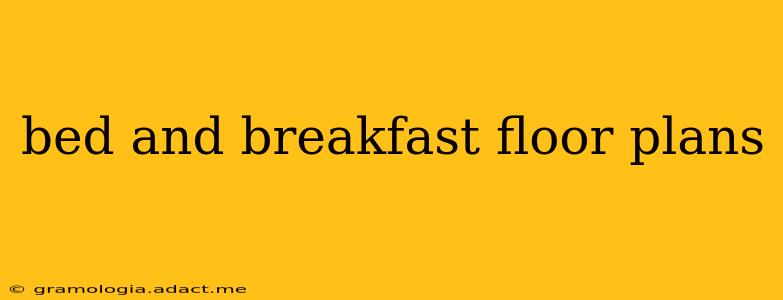Dreaming of opening your own charming bed and breakfast? A well-designed floor plan is crucial to creating a welcoming and efficient space for both you and your guests. This guide will delve into the key considerations for crafting the perfect bed and breakfast floor plan, covering everything from guest room layouts to maximizing common areas. We’ll also explore some common questions prospective innkeepers often have.
What are the essential elements of a successful B&B floor plan?
A successful B&B floor plan balances guest comfort with operational efficiency. Essential elements include:
-
Guest Rooms: These should be comfortable, well-appointed, and offer privacy. Consider factors like ensuite bathrooms, ample closet space, and the placement of windows for natural light. The number of rooms will depend on your property size and target market.
-
Common Areas: These are the heart of your B&B, fostering a sense of community and relaxation. A comfortable sitting area, a dining room for breakfast, and perhaps a cozy reading nook are key features.
-
Owner's Quarters: Ensure you have separate and private living space, including a bedroom, bathroom, and potentially a home office. This allows for a balance between hosting guests and maintaining your personal life.
-
Kitchen & Service Areas: The kitchen needs to be large enough to prepare breakfast for multiple guests efficiently. Consider adding a separate pantry or storage area for supplies. Also, think about a dedicated area for cleaning and laundry.
-
Accessibility: Designing for accessibility is crucial for inclusivity. Consider features like wider doorways, ramps, and grab bars in bathrooms, to cater to guests with mobility challenges.
What are the different types of B&B floor plans?
B&B floor plans vary greatly depending on the size and style of the property. Common types include:
-
Single-Story B&Bs: Ideal for smaller properties or those with limited mobility access. These offer easy navigation and a more intimate feel.
-
Multi-Story B&Bs: Allow for more guest rooms and separation between guest and owner areas. However, they may require more extensive renovations and maintenance.
-
Converted Buildings: Adapting existing structures into B&Bs requires creative floor plan design to maximize space and incorporate modern amenities while retaining the building's character.
How much space do I need per guest room?
While there's no strict rule, aim for at least 200 square feet per guest room to ensure comfort and ample space for luggage and furniture. Larger rooms are preferable, especially for suites or rooms with extra features like sitting areas.
What are some tips for designing a B&B floor plan?
-
Prioritize flow: Ensure a smooth flow between different areas of the B&B to minimize guest disruption and streamline operations.
-
Maximize natural light: Natural light enhances the atmosphere and reduces the need for artificial lighting.
-
Consider soundproofing: Soundproofing between guest rooms and common areas is essential to ensure guest privacy.
-
Utilize space efficiently: Clever design can maximize the use of space, especially in smaller properties.
-
Think about parking: Adequate parking for guests and staff is essential.
What about incorporating outdoor spaces?
Outdoor spaces, such as patios, gardens, or balconies, can greatly enhance the guest experience. These areas offer additional relaxation spaces and can be incorporated into the overall floor plan design.
What are some examples of popular B&B floor plan layouts?
Numerous layouts exist, from simple to complex, depending on your needs and property. Consulting with an architect or interior designer experienced in B&B design is highly recommended to create a floor plan optimized for your specific needs and vision. They can help you navigate zoning regulations and ensure your design meets all building codes.
Conclusion: Crafting Your Perfect B&B
Designing a bed and breakfast floor plan is a crucial step in bringing your dream to life. By carefully considering the factors discussed above and consulting with professionals, you can create a functional and welcoming space that ensures both your success and your guests' memorable stays. Remember, a well-planned layout is an investment in the future success of your inn.
